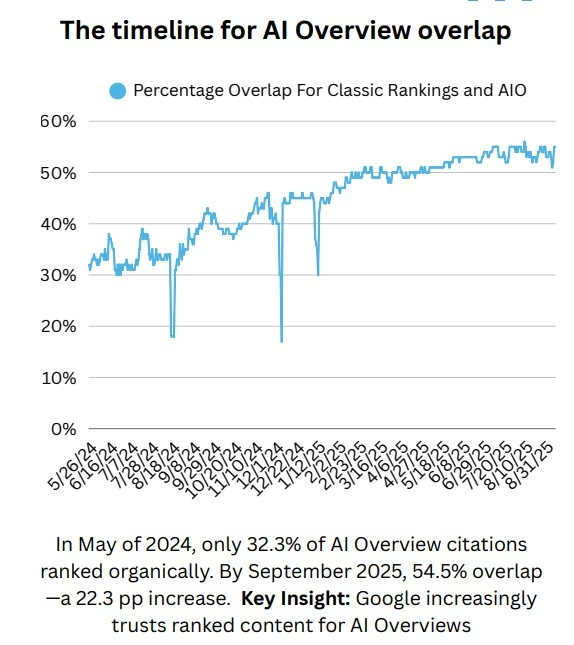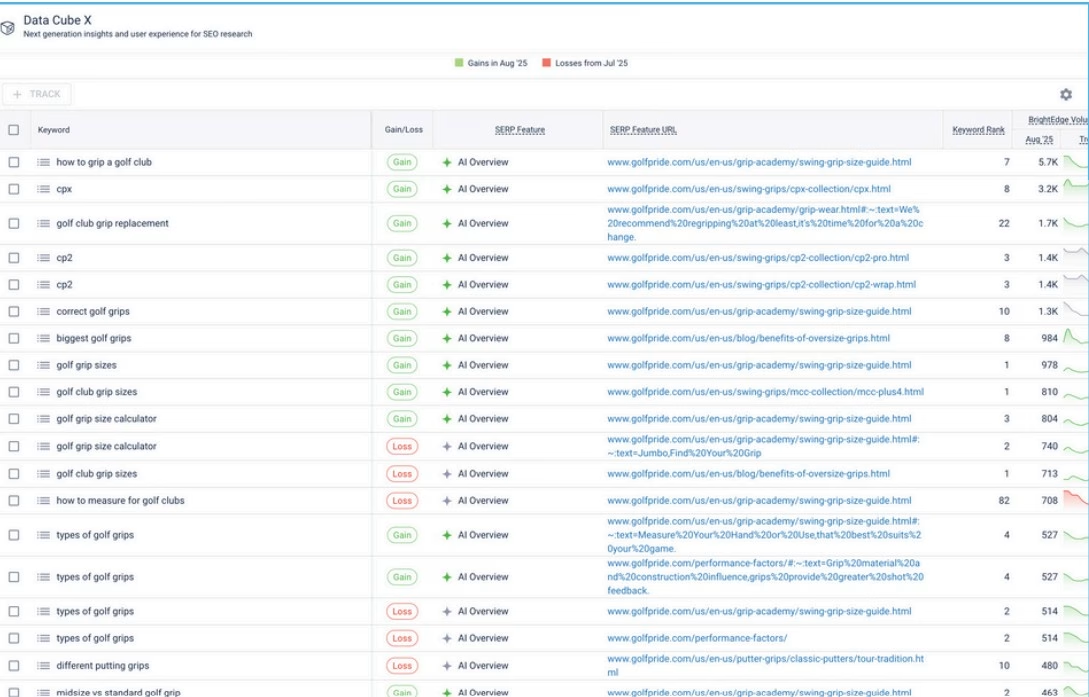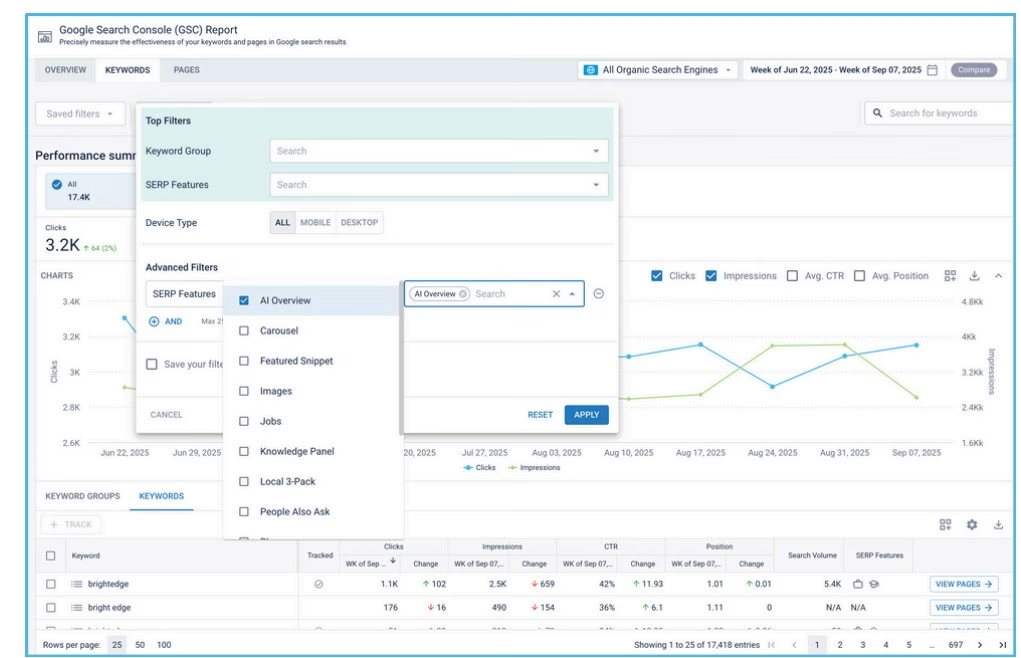Table of Contents


Want to Boost Rankings?
Get a proposal along with expert advice and insights on the right SEO strategy to grow your business!
Get StartedAccording to BrightEdge AI Overviews report, in just 16 months, the way Google’s AI Overviews cite content has changed dramatically.
Back in May 2024, only 32.3% of AI Overview citations came from content already ranking organically.
- How Much Have AI Overviews Converged with Organic Rankings?
- What Were the Key Phases in AI Overview Convergence?
- Which Industries Are Leading and Which Are Lagging?
- Why Does Google Trust Ranked Content for AI Overviews?
- How Should Marketers Adapt Their SEO Strategies?
- What Tools Help Track AI and SEO Together?
- What Are the Big Takeaways for Businesses?
Free SEO Audit: Uncover Hidden SEO Opportunities Before Your Competitors Do
Gain early access to a tailored SEO audit that reveals untapped SEO opportunities and gaps in your website.

Fast-forward to September 2025 and that number has risen to 54.5%. This is not just a minor adjustment but a fundamental shift in how AI-powered search integrates with traditional rankings.
What does this mean for SEO?
Simply put: Google is showing increasing trust in ranked content to power its AI summaries. But the impact is uneven across industries, with some sectors racing ahead while others lag behind.
How Much Have AI Overviews Converged with Organic Rankings?
The latest BrightEdge study monitoring 9 industries over 16 months shows a clear trend: AI Overview citations and organic rankings are converging.

- May 2024 baseline: 32.3% overlap.
- September 2025 current: 54.5% overlap.
- Net change: +22.3 percentage points.
That is a 69% relative increase in overlap. For marketers, it signals that optimizing for search rankings is no longer just about clicks—it’s about being chosen as the source for AI-powered summaries.
But the journey has not been smooth. The convergence unfolded in three distinct phases.
What Were the Key Phases in AI Overview Convergence?
The 16-month journey can be divided into Testing, Acceleration and Convergence.
Phase 1: Testing (May–August 2024)
This was Google’s experiment period. Overlap hovered flat between 32–34%. Some industries didn’t even have AIOs enabled. It felt more like Google was trying different content sourcing models rather than committing to ranked results.
Phase 2: Acceleration (September 2024–January 2025)
Then came the public rollout in September 2024. Overnight, things shifted. Overlap jumped from 34.6% to 39.1%, gaining +5.4 pp in just two months. By January 2025, overlap had risen to 45.2%. This was the fastest growth stage—averaging nearly 3 percentage points per month.
Phase 3: Convergence (February–September 2025)
From February onward, growth continued but at a steadier pace. Overlap rose from 45.2% to 54.5%. In May 2025, the 50% threshold was crossed which is a symbolic moment where the majority of AI Overviews finally drew from organically ranking pages. By September, the trend stabilized around 54%, suggesting this could be Google’s target equilibrium.
So, what we see is a deliberate design: Google tested, scaled fast during rollout and is now consolidating.
Which Industries Are Leading and Which Are Lagging?
The overall number of 54.5% overlap is only half the story. The industry-level breakdown shows stark differences.

High Convergence Sectors (68–75%)
| Sector | Convergence % | Change (pp) |
|---|---|---|
| Healthcare | 75.3% | +12.0 |
| Education | 72.6% | +53.2 |
| B2B Tech | 71.0% | +32.4 |
| Insurance | 68.6% | +47.7 |
These are YMYL industries (Your Money, Your Life), where trust and authority are critical. For Google, it makes sense: if you’re giving medical, financial or educational answers, you want the most reliable and proven content sources.
Low Convergence Sectors (<33%)
| Sector | Convergence % | Change (pp) |
| Finance | 32.2% | Flat/slow |
| Entertainment | 25.9% | Late growth |
| Travel | 23.6% | Minimal |
| E-commerce | 22.9% | +0.6 |
| Restaurants | 19.2% | Minimal |
E-commerce stands out as an anomaly. Despite the surge elsewhere, Google has barely shifted overlap here. Why? Likely to avoid bias in commercial queries where AI-generated answers could look like endorsements or ads.
Why Does Google Trust Ranked Content for AI Overviews?
This convergence isn’t random. It reflects a deeper principle: if content is ranking, it has already passed trust, quality and authority tests.
But here is an interesting twist:
- Most AIO citations come from pages ranked 21–100, not the top 10.
- Only 16.7% of citations originate from page-one results.
This suggests Google is intentionally diversifying sources. Instead of just picking the very top-ranked pages, it’s pulling from a broader pool of trusted but less visible content. That means even “buried” content has a real shot at AI citation visibility.
What Changed in September 2024?
The public rollout was the turning point. From that moment, Google committed to aligning AI Overviews with ranked content.
- Overlap jumped +5.4 pp in just two months.
- Education and Insurance industries saw massive surges.
- Non-ranking content citations dropped significantly.
This was effectively Google telling the world: SEO matters for AI too.
How Should Marketers Adapt Their SEO Strategies?
If AI Overviews now depend on organic trust signals, the question is—how do we optimize?
Identify Your Overlap Profile:
Track how much of your AIO visibility overlaps with rankings. Benchmark against the 54% industry average.
Match Strategy to Intent:
- If you are above 60% overlap (like healthcare), double down on SEO basics.
- If you’re below 30% (like e-commerce), you’ll need dual strategies—SEO + dedicated AI targeting.
- If you are in the middle (30–60%), create content that serves both.
Monitor Convergence Trends:
Industry overlap has grown +22 pp in 16 months. Watch for jumps like September 2024’s rollout or May 2025’s 50% milestone.
What Tools Help Track AI and SEO Together?
BrightEdge has been at the forefront of monitoring this shift with its Generative Parser™. Other tools worth noting include:
- Data Cube X: Tracks monthly AIO gains and losses.

- AI Catalyst: Analyzes your content against cited pages to suggest on-page optimizations.

- GSC Reporting: Helps unify search visibility and AI Overview performance.

Together, they point to a future where SEO and AI optimization can no longer be separate disciplines.
What Are the Big Takeaways for Businesses?
The convergence of AI Overviews with organic rankings offers several clear lessons:
- The shift is real but uneven. Some industries are racing ahead, while others lag significantly.
- YMYL industries are driving the trend. When trust is at stake, AI leans on proven organic results.
- E-commerce remains an anomaly, suggesting Google is intentionally limiting AI in transactional queries.
- Rankings beyond page one matter. The majority of citations are pulled from positions 21–100, not just the top 10.
- Stabilization signals a new normal. With overlap holding at around 54%, this could represent Google’s preferred balance point.
About the author
Share this article
Find out WHAT stops Google from ranking your website
We’ll have our SEO specialists analyze your website—and tell you what could be slowing down your organic growth.














